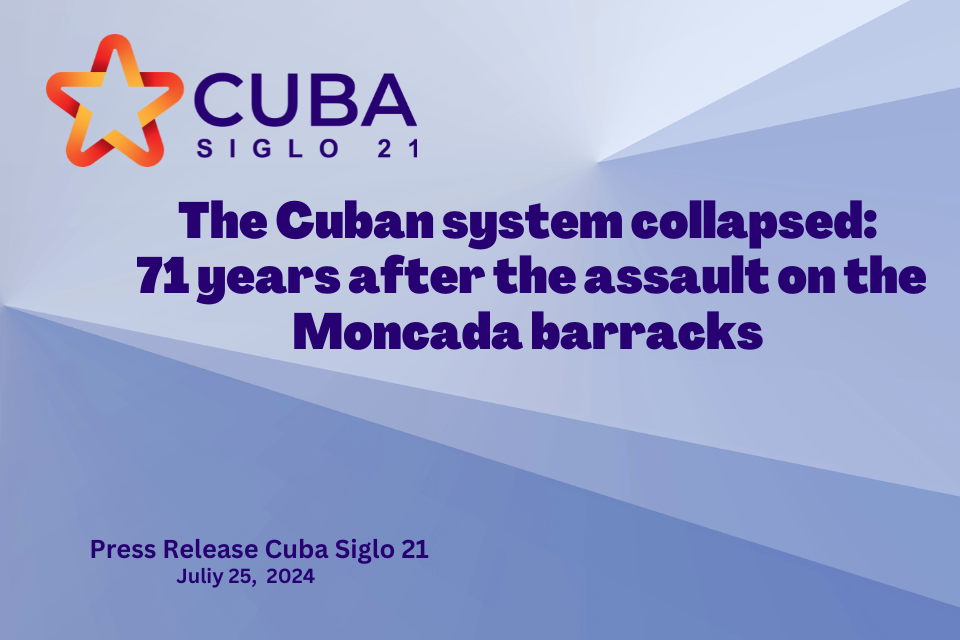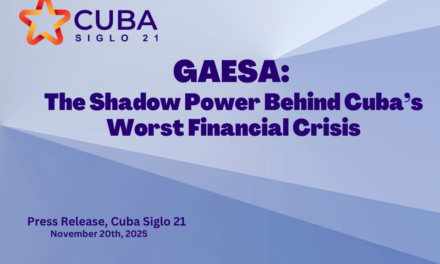Descargar informe completo en pdf
Download complete report in pdf
Ver resumen en español
See Summary in English
July 25, 2024. On the 71st anniversary of the military assault to Moncada garrison by Fidel Castro Cuba Siglo 21 assesses the state of the country. Emilio Morales, author of the Dossier Cuba 21 No. 23 “The Cuban system collapsed: 71 years after the assault on the Moncada barracks” presents an statistical X-ray of the collapse of the Cuban system.
The Cuban economy is in a critical phase due to the drastic fall of more than 50% of its main sources of income: exports of medical services, remittances and tourism. This financial collapse has accelerated the regime of governance countdown, says economist Morales.
Medical Services Exports Plunge
The export of medical services, the country’s main source of income, has suffered a 78.12% drop since its peak in 2013, when it reached US$10.42 billion.
Remittance Decline
Remittances, the second largest source of income, have also declined significantly. In 2023, remittances totaled $1,972.56 million, a drop of 3.31% from 2022 and 46.93% compared to 2019, before the pandemic. This decline is attributed to the massive emigration that began after the crackdown on the July 11, 2021 protests, which has not only reduced remittances but also resulted in a significant flight of human capital.
Failure of Tourism
Tourism, one of Cuba’s most promising industries, has failed in its post-pandemic recovery. In 2023, Cuba received 2,436,979 tourists, a figure comparable to 2009, well below expected levels. By comparison, the Dominican Republic surpassed 10 million tourists in 2023. The situation is aggravated by the decline of Cuban tourists residing abroad, a key segment for the Cuban tourism economy.
The regime’s bid to attract Russian tourists has not compensated for the loss of European tourism, affected by Cuba’s support to Russia in the war against Ukraine. Tourist arrivals from the five main European issuers (Italy, France, Germany, Spain and England) have decreased by 67.45% in the last five years.
Conclusions
The Cuban regime has proven incapable of implementing effective mechanisms to transform the economy and overcome the current multi-systemic crisis. The fall of the three main sources of income by more than 50% reflects the total dysfunctionality of the regime of governance.
Even the government’s political allies are unwilling to undertake a large-scale economic rescue. The governance models of Russia, China or Vietnam have not been adopted, and Cuba’s power elite remains resistant to any changes that would open the economy to the market.
The economic crisis has had devastating effects on all sectors of society. There is an alarming deficit of teachers, health personnel, workers in the sugar industry, tourism and the energy system. Even the justice system is affected, with the Supreme Court of Justice operating at only 69% of its capacity.
Mass emigration has decapitalized the country financially and in terms of human resources, and the metamorphosis of Castroism into a mafia state, with GAESA as the center of real power, has led to the destruction of industries and the loss of political capital. The Communist Party of Cuba (PCC) finds itself without a recycling pool, with many militants who no longer believe in the party or its ideology.
With the celebration of the 71st anniversary of the assault on the Moncada barracks, Cuba finds itself in a deep humanitarian crisis, with 89% of the population in poverty and 1.79 million citizens who have left the country in recent years.
Morales concludes that ” The Cuban system has collapsed. The Cuban state is dysfunctional and bankrupt. The Cuban government is mediocre and lacks leadership. The Cuban power elite is impervious to criticism. Without radical transformation of some kind to prevent or postpone it, the ultimate downfall, by one means or another, is inevitable”.
Descargar informe completo en pdf
Download complete report in pdf
Ver resumen en español
See Summary in English







